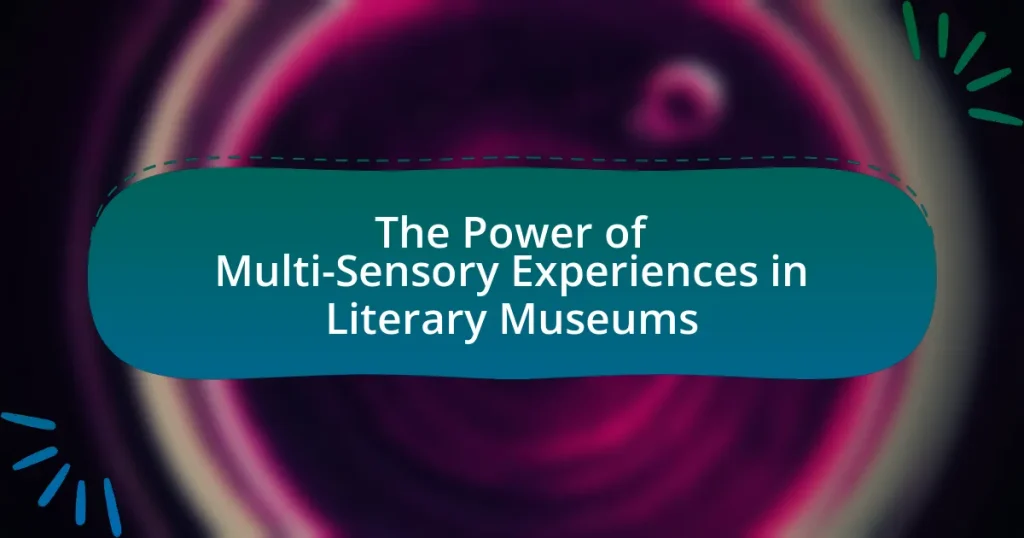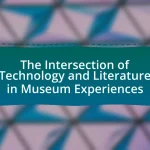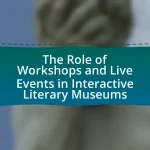Multi-sensory experiences in literary museums are interactive engagements that stimulate multiple senses—sight, sound, touch, taste, and smell—to enhance the understanding and appreciation of literary works. These experiences include immersive installations, audio guides, tactile exhibits, and themed environments that deepen visitors’ connections with literature. The article explores how these experiences improve visitor engagement, learning, and retention by catering to diverse audiences and incorporating various sensory elements. It also addresses the challenges of implementing such experiences, including resource allocation, technological integration, and accessibility, while highlighting best practices for designing inclusive and effective multi-sensory environments in literary museums.
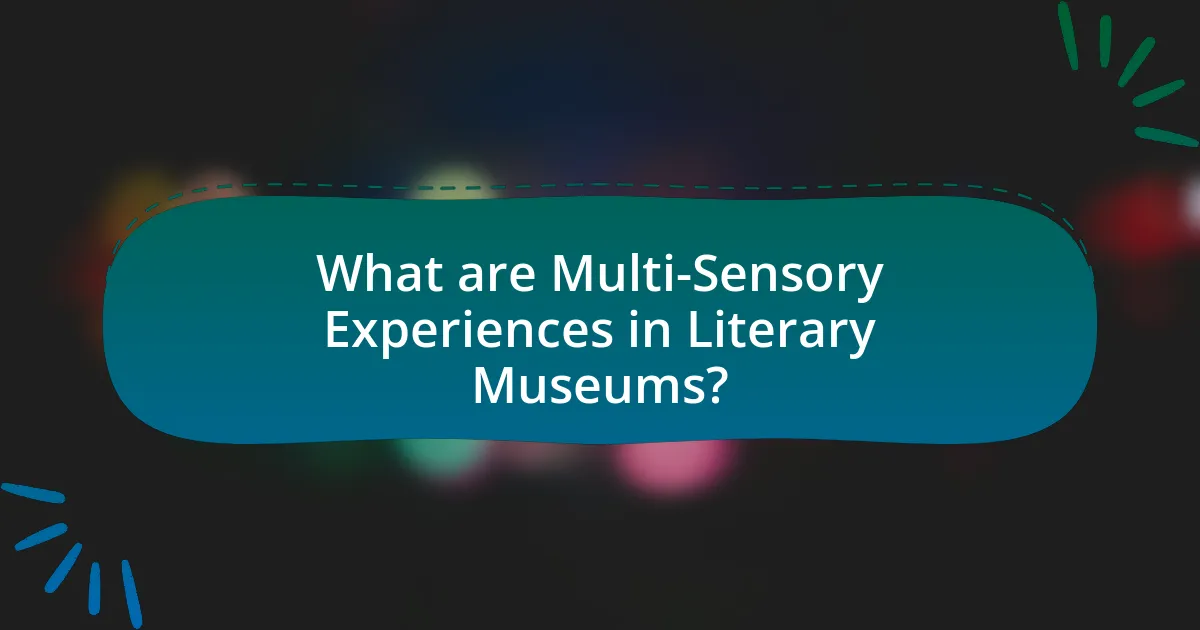
What are Multi-Sensory Experiences in Literary Museums?
Multi-sensory experiences in literary museums are interactive engagements that stimulate multiple senses—sight, sound, touch, taste, and smell—to enhance the understanding and appreciation of literary works. These experiences often include immersive installations, audio guides, tactile exhibits, and themed environments that allow visitors to connect more deeply with the literature and its context. For instance, a literary museum might feature a recreated setting from a novel, complete with ambient sounds and scents that evoke the story’s atmosphere, thereby enriching the visitor’s emotional and intellectual experience.
How do Multi-Sensory Experiences enhance visitor engagement?
Multi-sensory experiences enhance visitor engagement by stimulating multiple senses simultaneously, which increases emotional connection and retention of information. Research indicates that engaging sight, sound, touch, taste, and smell can create a more immersive environment, leading to deeper involvement and satisfaction among visitors. For instance, a study published in the Journal of Experiential Education found that multi-sensory learning environments can improve memory recall by up to 50%, demonstrating the effectiveness of this approach in enhancing visitor experiences in settings like literary museums.
What senses are typically engaged in these experiences?
Multi-sensory experiences in literary museums typically engage sight, sound, touch, and sometimes smell. These senses are activated through visual displays, auditory elements like readings or soundscapes, tactile interactions with exhibits, and olfactory cues that enhance the thematic atmosphere. Research indicates that engaging multiple senses can significantly enhance visitor engagement and retention of information, as demonstrated in studies on sensory learning environments.
How do these experiences differ from traditional museum visits?
Multi-sensory experiences in literary museums differ from traditional museum visits by engaging multiple senses, enhancing emotional connections and understanding of the exhibits. Traditional museum visits typically focus on visual displays and textual information, limiting visitor interaction and engagement. In contrast, multi-sensory experiences incorporate elements such as sound, touch, and smell, allowing visitors to immerse themselves in the literary context. For example, a literary museum may use audio readings, tactile artifacts, and scent elements related to the author’s work, which can deepen the visitor’s appreciation and comprehension of the literature. This approach aligns with research indicating that multi-sensory engagement can significantly enhance learning and retention, as demonstrated in studies on experiential learning in educational settings.
Why are Multi-Sensory Experiences important in Literary Museums?
Multi-sensory experiences are important in literary museums because they enhance engagement and understanding of literary works. By incorporating visual, auditory, and tactile elements, these experiences allow visitors to connect more deeply with the narratives and themes presented in literature. Research indicates that multi-sensory approaches can improve memory retention and emotional responses, making the literary content more impactful. For instance, a study published in the Journal of Museum Education found that visitors who engaged with multi-sensory exhibits reported a 30% increase in their overall enjoyment and comprehension of the material compared to traditional displays. This evidence underscores the significance of multi-sensory experiences in fostering a richer appreciation of literature within museum settings.
What impact do they have on learning and retention?
Multi-sensory experiences in literary museums significantly enhance learning and retention. Engaging multiple senses—such as sight, sound, touch, and smell—creates a richer and more immersive educational environment, which has been shown to improve memory recall. Research indicates that when individuals interact with content through various sensory modalities, they are more likely to retain information; for instance, a study published in the journal “Educational Psychology” found that multi-sensory learning can increase retention rates by up to 50%. This is because the brain processes and encodes information more effectively when it is presented in diverse formats, leading to deeper understanding and longer-lasting memory.
How do they cater to diverse audiences?
Literary museums cater to diverse audiences by incorporating multi-sensory experiences that engage various learning styles and preferences. These museums utilize interactive exhibits, audio guides, tactile displays, and immersive environments to appeal to visual, auditory, and kinesthetic learners. For example, the British Library offers sound recordings and interactive installations that allow visitors to experience literature in a dynamic way, enhancing accessibility for individuals with different abilities and backgrounds. This approach not only broadens the appeal of literary content but also fosters inclusivity, ensuring that all visitors can connect with the material in a meaningful manner.
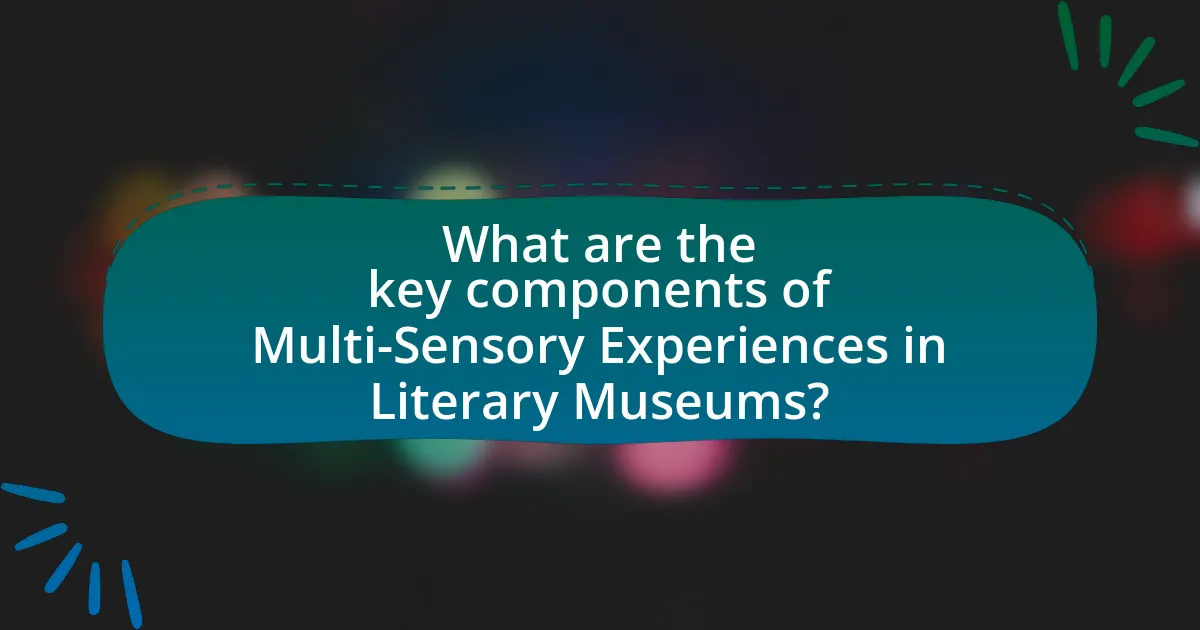
What are the key components of Multi-Sensory Experiences in Literary Museums?
The key components of Multi-Sensory Experiences in Literary Museums include visual elements, auditory components, tactile interactions, olfactory stimuli, and interactive technology. Visual elements such as displays of manuscripts, photographs, and artifacts engage visitors’ sight, while auditory components like readings, soundscapes, and music enhance the narrative experience. Tactile interactions allow visitors to handle replicas or engage with interactive exhibits, fostering a deeper connection. Olfactory stimuli, such as scents related to the literary works or historical context, can evoke memories and emotions. Finally, interactive technology, including augmented reality and virtual reality, provides immersive experiences that bring literary narratives to life. These components collectively create a rich, engaging environment that enhances understanding and appreciation of literature.
What types of sensory elements are incorporated?
Literary museums incorporate various sensory elements, including visual, auditory, tactile, and olfactory components. Visual elements often consist of artwork, artifacts, and interactive displays that engage visitors’ sight. Auditory elements may include soundscapes, readings, or recorded interviews that enhance the narrative experience. Tactile components allow visitors to physically interact with exhibits, fostering a deeper connection. Olfactory elements, such as scents related to specific literary works or periods, evoke memories and emotions, enriching the overall experience. These sensory elements collectively create an immersive environment that enhances visitor engagement and understanding of literary themes.
How does visual storytelling play a role?
Visual storytelling plays a crucial role in enhancing engagement and comprehension in literary museums. By integrating visual elements such as images, videos, and interactive displays, museums can convey complex narratives and emotions more effectively than text alone. Research indicates that visuals can increase retention rates by up to 65%, as they stimulate both cognitive and emotional responses, making the experience more memorable. This multi-sensory approach not only attracts diverse audiences but also fosters a deeper connection to the literary works being showcased, ultimately enriching the visitor experience.
What auditory elements enhance the experience?
Auditory elements that enhance the experience in literary museums include ambient sounds, spoken word performances, and curated soundscapes. Ambient sounds, such as nature sounds or background chatter, create an immersive environment that reflects the themes of the exhibits. Spoken word performances, featuring readings from literary works, engage visitors by bringing texts to life and fostering emotional connections. Curated soundscapes, which may include music or sound effects relevant to the literary context, further enrich the atmosphere and deepen the visitor’s understanding of the material. Research indicates that multi-sensory experiences, including auditory elements, significantly improve visitor engagement and retention of information in museum settings.
How is technology utilized in creating Multi-Sensory Experiences?
Technology is utilized in creating multi-sensory experiences by integrating various digital tools and interactive elements that engage multiple senses simultaneously. For instance, virtual reality (VR) immerses users in a 3D environment, allowing them to see, hear, and interact with literary themes and characters, enhancing emotional connections. Augmented reality (AR) applications overlay digital information onto physical exhibits, providing auditory and visual stimuli that enrich the storytelling experience. Additionally, sensory installations, such as scent diffusion and tactile displays, further engage the sense of smell and touch, creating a holistic experience that resonates with visitors. Research indicates that these technologies can significantly enhance visitor engagement and retention of information, as evidenced by studies showing that multi-sensory experiences can improve memory recall by up to 70%.
What role do interactive displays play?
Interactive displays serve as essential tools in literary museums by enhancing visitor engagement and facilitating immersive learning experiences. These displays allow visitors to interact with content through touch, movement, and multimedia elements, which can lead to deeper understanding and retention of literary themes and historical contexts. Research indicates that interactive exhibits can increase visitor satisfaction and learning outcomes, as evidenced by a study published in the Journal of Museum Education, which found that interactive elements significantly improved visitor recall of information compared to traditional displays.
How can virtual reality be integrated into these experiences?
Virtual reality can be integrated into literary museum experiences by creating immersive environments that allow visitors to engage with literary works in a three-dimensional space. This technology enables users to explore settings from novels, interact with characters, and experience narratives in a way that traditional exhibits cannot provide. For instance, a virtual reality experience based on a classic novel could allow users to walk through the story’s landscape, enhancing their understanding and emotional connection to the text. Studies have shown that immersive experiences can significantly increase retention and engagement, making virtual reality a powerful tool for educational purposes in literary museums.
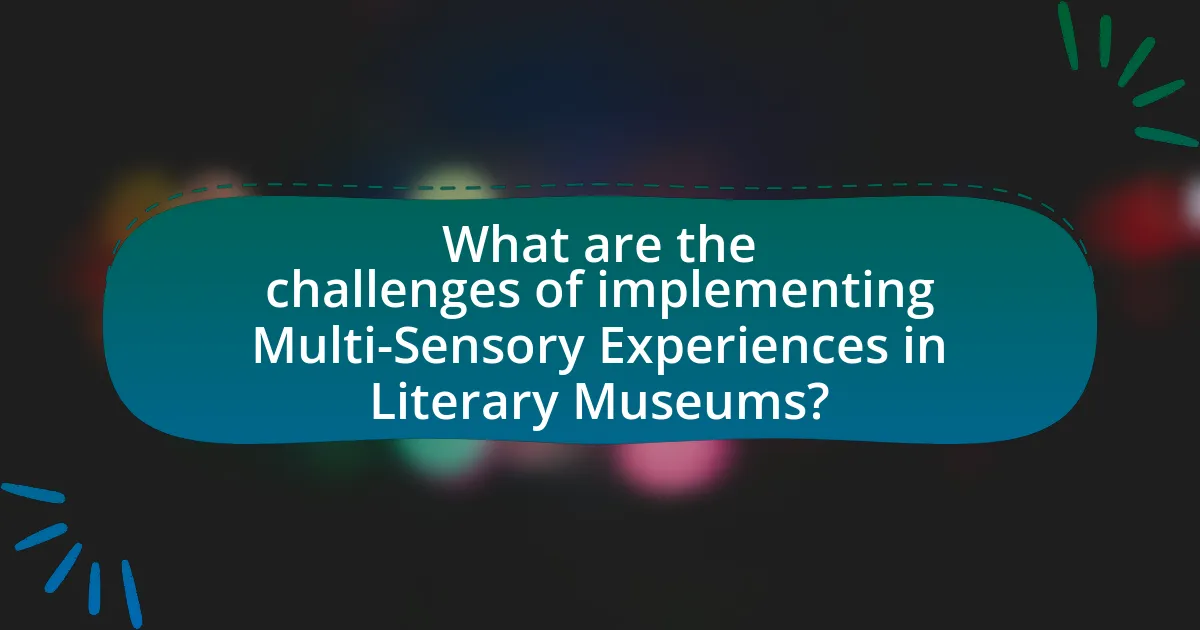
What are the challenges of implementing Multi-Sensory Experiences in Literary Museums?
Implementing multi-sensory experiences in literary museums faces several challenges, including resource allocation, technological integration, and audience accessibility. Resource allocation is critical, as developing and maintaining multi-sensory installations often requires significant financial investment and skilled personnel. Technological integration poses another challenge, as museums must ensure that the technology used is reliable, user-friendly, and compatible with existing systems. Additionally, audience accessibility is a concern, as not all visitors may have the same sensory capabilities, necessitating careful consideration of how to create inclusive experiences that cater to diverse needs. These challenges highlight the complexities involved in enhancing literary museums through multi-sensory approaches.
What logistical issues must be addressed?
Logistical issues that must be addressed in the context of multi-sensory experiences in literary museums include the integration of technology, space management, and accessibility. The integration of technology is crucial for creating immersive experiences; for instance, ensuring that audio-visual equipment is compatible and functional can enhance visitor engagement. Space management involves designing layouts that accommodate various sensory activities without overcrowding, which is essential for maintaining a comfortable visitor experience. Accessibility must also be prioritized to ensure that all visitors, including those with disabilities, can fully engage with the exhibits. Addressing these logistical issues is vital for the successful implementation of multi-sensory experiences in literary museums.
How can budget constraints impact the development of these experiences?
Budget constraints can significantly limit the development of multi-sensory experiences in literary museums by restricting the resources available for technology, staffing, and materials. When financial limitations are present, museums may struggle to invest in advanced interactive technologies, such as augmented reality or immersive soundscapes, which enhance visitor engagement. For instance, a study by the American Alliance of Museums found that 60% of museums reported budget constraints as a barrier to implementing innovative exhibits. Additionally, limited funding can lead to reduced staffing, impacting the quality of visitor interactions and educational programming. Consequently, budget constraints directly affect the ability of literary museums to create enriching, immersive experiences that attract and retain audiences.
What are the potential barriers to accessibility?
Potential barriers to accessibility in literary museums include physical obstacles, sensory limitations, and technological inadequacies. Physical obstacles such as stairs, narrow doorways, and inadequate signage can hinder access for individuals with mobility impairments. Sensory limitations, including visual and auditory challenges, may prevent full engagement with exhibits that rely heavily on sight or sound. Additionally, technological inadequacies, such as a lack of assistive devices or poorly designed websites, can further restrict access to information and experiences. According to the National Endowment for the Arts, approximately 20% of adults in the U.S. have a disability, highlighting the importance of addressing these barriers to ensure inclusivity in cultural spaces.
How can museums measure the success of Multi-Sensory Experiences?
Museums can measure the success of Multi-Sensory Experiences through visitor feedback, engagement metrics, and behavioral observations. Visitor feedback can be collected via surveys and interviews, allowing museums to assess emotional responses and satisfaction levels. Engagement metrics, such as time spent at exhibits and participation in interactive elements, provide quantitative data on visitor involvement. Behavioral observations, including tracking movement patterns and interactions with sensory elements, offer insights into how effectively the experiences capture attention and enhance understanding. Research indicates that immersive experiences can increase visitor retention and satisfaction, as evidenced by studies showing that multi-sensory engagement leads to higher recall and emotional connection with the content presented.
What metrics are useful for evaluating visitor satisfaction?
Useful metrics for evaluating visitor satisfaction include Net Promoter Score (NPS), Customer Satisfaction Score (CSAT), and Visitor Engagement Metrics. NPS measures the likelihood of visitors recommending the museum to others, providing insight into overall satisfaction and loyalty. CSAT gauges immediate satisfaction through post-visit surveys, allowing for direct feedback on specific experiences. Visitor Engagement Metrics, such as time spent in exhibits and participation in interactive elements, indicate how well the museum captivates its audience. These metrics collectively offer a comprehensive view of visitor satisfaction, supported by industry practices that emphasize the importance of feedback in enhancing visitor experiences.
How can feedback be effectively gathered and analyzed?
Feedback can be effectively gathered and analyzed through structured surveys, interviews, and observation methods. Structured surveys allow for quantitative data collection, enabling the measurement of visitor satisfaction and engagement levels in literary museums. Interviews provide qualitative insights, capturing personal experiences and suggestions for improvement. Observation methods, such as tracking visitor interactions with multi-sensory exhibits, yield valuable behavioral data. According to a study published in the Journal of Museum Education, utilizing a combination of these methods enhances the depth and reliability of feedback, leading to more informed decision-making in museum programming and exhibit design.
What best practices should be followed when designing Multi-Sensory Experiences?
When designing multi-sensory experiences, it is essential to integrate various sensory modalities to enhance engagement and understanding. This can be achieved by combining visual, auditory, tactile, olfactory, and gustatory elements in a cohesive manner. Research indicates that experiences engaging multiple senses can improve memory retention by up to 80%, as demonstrated in studies on sensory integration (Spence, 2011). Additionally, ensuring that the sensory elements are relevant to the content being presented is crucial; for instance, using soundscapes that reflect the themes of literary works can deepen emotional connections. Furthermore, providing opportunities for interactivity allows participants to engage actively, which has been shown to increase satisfaction and learning outcomes. Lastly, considering accessibility for individuals with sensory sensitivities or disabilities is vital to create inclusive experiences.
How can collaboration with artists and technologists enhance the experience?
Collaboration with artists and technologists can significantly enhance the experience in literary museums by integrating innovative multimedia elements that engage visitors on multiple sensory levels. This partnership allows for the creation of immersive installations that combine visual art, sound, and interactive technology, fostering deeper emotional connections to literary works. For instance, the use of augmented reality can bring literary scenes to life, while soundscapes can evoke the atmosphere of specific narratives, making the experience more memorable. Research indicates that multi-sensory engagement increases retention and understanding of content, as demonstrated in studies showing that interactive exhibits lead to higher visitor satisfaction and learning outcomes.
What strategies can ensure inclusivity in sensory design?
To ensure inclusivity in sensory design, employing a user-centered approach that incorporates diverse sensory modalities is essential. This strategy involves engaging individuals with varying abilities and preferences during the design process, ensuring that sensory experiences are accessible to all. Research indicates that multi-sensory environments can enhance engagement and understanding, particularly for individuals with disabilities. For instance, a study published in the Journal of Accessibility and Design for All highlights that incorporating tactile, auditory, and visual elements can significantly improve the experience for users with sensory processing disorders. By prioritizing feedback from a diverse user base and integrating adaptive technologies, sensory design can become more inclusive and effective in literary museums.
